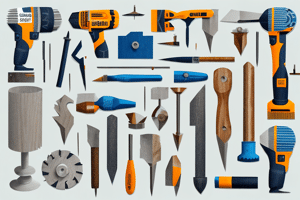UPDATED: March 17, 2024
Cooking is not just a skill reserved for professional chefs or food enthusiasts. It is an essential life skill that every man should master. Whether you're a bachelor living on your own or a family man responsible for feeding your loved ones, having basic culinary skills is a game-changer. So, let's dive into the world of cooking and explore the importance of culinary skills, essential kitchen tools, basic cooking techniques, using spices correctly, meal planning and preparation, food safety and hygiene, and the joy of cooking beyond the basics.
Understanding the Importance of Culinary Skills
Why should a man bother with culinary skills, you may wonder? Well, let me paint you a picture. Imagine being able to whip up a delicious and healthy meal from scratch, impressing your friends and family with your culinary prowess. Not only will you save money by cooking at home, but you'll also have full control over the ingredients, ensuring that you and your loved ones are eating nutritious meals.
Moreover, delving into the world of culinary arts opens up a realm of creativity and innovation. Experimenting with different flavors, textures, and cooking techniques can be a thrilling adventure. You might discover a hidden talent for pairing ingredients or develop a signature dish that becomes a family favorite. The possibilities are endless when you embrace the art of cooking.
Building Confidence in the Kitchen
One of the key benefits of developing culinary skills is the boost in confidence it brings. By mastering basic cooking techniques, you'll feel more comfortable and at ease in the kitchen. Gone will be the days of relying on takeout or frozen meals. Armed with these skills, you'll be able to create dishes that are not only delicious but tailored to your specific taste preferences.
Furthermore, honing your culinary skills can lead to a deeper appreciation for food and where it comes from. Understanding the origins of different ingredients, their seasonality, and how they complement each other can elevate your cooking to a whole new level. You may find yourself frequenting farmers' markets, exploring new cuisines, and developing a heightened awareness of the culinary world around you.
The Role of Cooking in Self-Sufficiency
Beyond building confidence, culinary skills promote self-sufficiency. No longer will you be reliant on others to provide you with meals. Instead, you'll have the ability to nourish yourself and your loved ones, fostering independence and self-reliance. Plus, who doesn't enjoy the satisfaction of cooking a delicious meal with their own two hands?
Additionally, mastering culinary skills can have a positive impact on your overall well-being. Cooking at home allows you to have full control over the nutritional content of your meals, helping you make healthier choices. It can also be a form of stress relief and a way to unwind after a long day. The act of chopping, sautéing, and simmering can be meditative, allowing you to focus on the present moment and savor the process of creating something delicious.
Essential Kitchen Tools for Every Man
Before we dive into the art of cooking, it's important to have the right tools at your disposal. Let's take a look at some essential kitchen tools that every man should have in his culinary arsenal.
Cooking is not just a task; it's an art form that requires precision and skill. To truly master the culinary craft, one must equip themselves with the finest tools available. From the sizzle of a perfectly seared steak to the delicate whisking of a fluffy omelette, the right kitchen tools can elevate your cooking experience to new heights.
Choosing the Right Cookware
Investing in quality cookware is the foundation of an efficient kitchen. Look for pots and pans that have a solid weight, even heat distribution, and are made of durable materials such as stainless steel or cast iron. With the right cookware, you'll be able to achieve optimal cooking results.
When selecting cookware, consider the versatility of each piece. A good saucepan can double as a small pot for boiling eggs or cooking grains, while a sturdy cast iron skillet can seamlessly transition from stovetop to oven, allowing you to sear, bake, and broil with ease. Remember, quality cookware is not just an investment in your kitchen; it's an investment in your culinary prowess.
Must-Have Utensils for Cooking
Aside from cookware, having a set of essential utensils will make your cooking experience smoother. Ensure you have a sturdy chef's knife, a cutting board, measuring cups and spoons, a spatula, and a whisk. These tools will be your trusty companions in the kitchen, facilitating efficient meal preparation.
Every great dish starts with the right tools. A sharp chef's knife is the cornerstone of any kitchen, allowing you to slice, dice, and chop with precision. A reliable cutting board provides a stable surface for all your culinary creations, while measuring cups and spoons ensure accuracy in your recipes. Let's not forget the humble spatula and whisk, essential for flipping pancakes with finesse and whipping up fluffy meringues with ease.
Mastering Basic Cooking Techniques
Now that you're equipped with the right tools, it's time to dive into the world of basic cooking techniques. Let's explore some fundamental skills that will elevate your culinary creations.
The Art of Sautéing and Pan Frying
Sautéing and pan frying are versatile cooking techniques that involve cooking food over medium to high heat in a shallow pan with a small amount of oil or fat. These methods allow for quick cooking while preserving the natural flavors and textures of the ingredients. Mastering sautéing and pan frying opens up a world of possibilities, from searing a perfectly juicy steak to creating flavorful stir-fries.
Imagine the sizzle of the pan as you gently place thinly sliced garlic into a hot skillet with a drizzle of olive oil. The aroma fills the air, and you can almost taste the rich, nutty flavor that will infuse your dish. As the garlic turns golden brown, you carefully add in vibrant, colorful vegetables, watching them transform from raw to tender-crisp. The sound of the sizzle intensifies as you toss the ingredients, ensuring even cooking and a perfect caramelization. With each flip of the spatula, you feel a sense of control and mastery over the heat, creating a symphony of flavors that will delight your taste buds.
Perfecting the Boiling and Simmering Process
Boiling and simmering are the building blocks of many dishes, from pasta to soups and stews. Knowing how to achieve the right temperature and timing is crucial for achieving the desired results. Boiling involves cooking food in liquid at a rolling boil, while simmering refers to cooking at a gentle bubble. By mastering these techniques, you'll be able to create hearty soups and cook pasta to al dente perfection.
Picture a pot of water coming to a rapid boil on your stovetop. You carefully add in a handful of vibrant green vegetables, watching them dance in the bubbling water. The vibrant colors start to fade as the vegetables soften, releasing their natural flavors into the surrounding liquid. As you taste a piece, you can feel the perfect balance between tenderness and a slight crunch. The simmering process, on the other hand, is like a gentle lullaby for your ingredients. The liquid barely trembles, creating a serene environment for flavors to meld together and develop complexity. Whether you're simmering a rich tomato sauce or a fragrant broth, this technique allows you to coax out the essence of each ingredient, creating a symphony of flavors.
The Science of Baking and Roasting
Baking and roasting are culinary techniques that require precision and attention to detail. Baking involves cooking food using dry heat in an enclosed space, such as an oven, while roasting refers to cooking food uncovered with the use of heat from above. These techniques are perfect for unleashing your creativity with bread, pastries, and succulent roasted meats.
Imagine the smell of freshly baked bread wafting through your kitchen, filling every nook and cranny with its irresistible aroma. As you carefully measure out the ingredients and mix them together, you can feel the dough come alive in your hands. With each knead and fold, you're creating a network of gluten that will give your bread its structure and chewiness. As the dough rises, you can't help but feel a sense of anticipation. The oven preheats, and you gently place the dough inside, watching it transform into a golden-brown masterpiece. The crust crackles as you break it apart, revealing a soft, pillowy interior that's still warm from the oven.
Roasting, on the other hand, is like a slow dance between heat and food. As you place a perfectly seasoned piece of meat on a roasting rack, you can almost hear the sizzle as the heat sears the surface, sealing in the juices. The aroma of herbs and spices fills the air, creating an intoxicating atmosphere. The meat slowly cooks, basting in its own juices, resulting in a tender, succulent texture that melts in your mouth. Each bite is a revelation, with flavors that are deep, rich, and perfectly balanced.
Understanding and Using Spices Correctly
Spices are the secret weapons that elevate dishes from ordinary to extraordinary. Let's delve into the world of spices and learn how to use them correctly.
Spices have a fascinating history that dates back thousands of years. They were highly prized commodities in ancient civilizations and were often used as currency. The spice trade played a significant role in shaping world history, leading to the exploration of new lands and the establishment of trade routes.
The Basics of Seasoning
Seasoning your food is the key to unlocking its full potential. Salt and pepper are the basics, but don't be afraid to experiment with a variety of herbs and spices such as garlic, paprika, cumin, and cinnamon. Be mindful of the flavor profiles you want to achieve and season accordingly.
Each spice has its unique characteristics and health benefits. For example, turmeric is known for its anti-inflammatory properties, while ginger is praised for aiding digestion. By incorporating a diverse range of spices into your cooking, you not only enhance the flavor of your dishes but also boost their nutritional value.
Pairing Spices with Different Foods
Understanding how spices complement different ingredients will take your culinary creations to new heights. For example, the warm flavors of cinnamon and nutmeg pair beautifully with sweet dishes like apple pie, while the heat of chili powder adds a spicy kick to savory dishes such as chili con carne. Don't be afraid to get adventurous and experiment with different spice combinations.
When pairing spices with foods, consider the cooking method as well. Some spices are more potent when added at the beginning of cooking, while others are best sprinkled on just before serving to preserve their delicate flavors. By mastering the art of spice pairing, you can transform simple meals into gourmet experiences.
Meal Planning and Preparation
Now that you have the skills and knowledge, it's time to put them into action. Let's explore the importance of meal planning and efficient food preparation.
Meal planning goes beyond just saving time; it's a fundamental aspect of maintaining a healthy lifestyle. By strategically planning your meals, you can ensure that you are meeting your nutritional needs and avoiding the pitfalls of unhealthy eating habits. It allows you to make conscious decisions about what you put into your body, leading to better overall health and well-being.
Planning Balanced Meals
Meal planning is not only a time-saving technique but also a way to ensure you're consuming a balanced diet. Take some time each week to plan your meals, incorporating a variety of proteins, vegetables, and whole grains. This way, you can avoid the temptation of ordering takeout and opt for a nutritious homemade meal instead.
When planning your meals, consider factors such as portion sizes, food variety, and nutrient balance. Aim to include a rainbow of fruits and vegetables to ensure you're getting a wide range of vitamins and minerals. Incorporating lean proteins like chicken, fish, or legumes can help you feel full and satisfied, while whole grains provide essential fiber for digestive health.
Efficient Food Preparation Techniques
A well-prepared mise en place (French for "everything in its place") is the secret to seamless cooking. Before you start cooking, chop your ingredients, measure out your spices, and arrange everything within easy reach. This not only saves time but also allows you to focus on the cooking process itself, resulting in better-tasting dishes.
Efficient food preparation techniques not only streamline the cooking process but also make it more enjoyable. By organizing your kitchen workspace and prepping ingredients in advance, you can reduce stress and increase efficiency in the kitchen. This approach also promotes creativity and experimentation with different flavors and cooking methods, enhancing the overall dining experience.
Food Safety and Hygiene in the Kitchen
When it comes to cooking, safety and cleanliness are of utmost importance. Let's explore some essential food safety and hygiene practices to ensure the well-being of you and your loved ones.
Ensuring food safety and maintaining proper hygiene practices in the kitchen are crucial steps in preventing foodborne illnesses and promoting overall well-being. By following these guidelines, you can create a safe and healthy cooking environment for yourself and your family.
Proper Food Handling and Storage
Always practice good hygiene by washing your hands thoroughly before and after handling food. Additionally, make sure to store perishable items at the correct temperatures to prevent foodborne illnesses. Being diligent about food safety helps protect yourself and others from potential health risks.
Furthermore, when storing leftovers, ensure they are properly sealed in airtight containers to maintain freshness and prevent contamination. Labeling the containers with the date can help you keep track of how long the food has been stored and ensure timely consumption.
Maintaining a Clean Cooking Environment
Keep your cooking environment clean and organized to avoid cross-contamination and maintain a pleasant space to work in. After cooking, wash your utensils, cutting boards, and countertops with hot, soapy water. Regularly sanitizing your kitchen surfaces will keep harmful bacteria at bay.
In addition to cleaning surfaces, it's essential to wash fruits and vegetables thoroughly before consumption to remove any dirt, pesticides, or bacteria that may be present. Properly rinsing produce under running water can help reduce the risk of foodborne illnesses and ensure that you are consuming safe and healthy ingredients.
The Joy of Cooking: Beyond the Basics
Now that you've mastered the basics, it's time to spread your culinary wings and embrace the joy of cooking. Let's explore ways to expand your culinary horizons.
As you delve deeper into the world of cooking, consider the rich tapestry of different cuisines waiting to be explored. Cooking allows you to travel the world through flavors and spices, unlocking a treasure trove of culinary delights. From the comforting warmth of Italian pasta dishes to the fiery kick of spicy Indian curries, or the vibrant freshness of authentic Mexican tacos, each cuisine offers a unique sensory experience. Embrace the diversity of flavors and techniques, and let your taste buds embark on a delicious adventure that knows no bounds.
Exploring Different Cuisines
Cooking allows you to travel the world through flavors and spices. Experiment with dishes from different cuisines, such as Italian pasta dishes, spicy Indian curries, or authentic Mexican tacos. Embrace the diversity of flavors and techniques, and let your taste buds embark on a delicious adventure.
As you journey through the culinary landscape, don't be afraid to push the boundaries of your kitchen prowess. Challenge yourself by stepping out of your comfort zone and experimenting with new recipes that pique your interest. Whether it's tackling a complex dessert that tests your baking skills or attempting a savory dish you've never cooked before, each new recipe is an opportunity for growth and learning. With your solid foundation of culinary skills, you'll be well-equipped to tackle any culinary challenge that comes your way.
Experimenting with New Recipes
Continue to challenge yourself by trying out new recipes. Whether it's tackling a complex dessert or attempting a dish you've never cooked before, don't be afraid to step outside your comfort zone. With your solid foundation of culinary skills, you'll be able to tackle any recipe with confidence.
Now that you have a deeper understanding of the importance of culinary skills, essential kitchen tools, basic cooking techniques, spice usage, meal planning, food safety, and the joy of cooking, it's time to don your apron and start experimenting. Remember, the kitchen is your canvas, and by mastering these skills, you'll be able to create culinary masterpieces that nourish both body and soul. Happy cooking!





